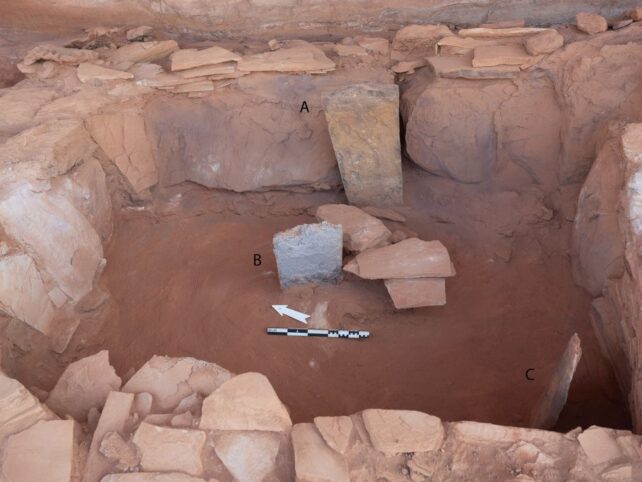 Interlocking stone cells found outside of the base of mustatil IDIHA-F-0011081.(Kennedy et al., PLOS One, 2023)
Interlocking stone cells found outside of the base of mustatil IDIHA-F-0011081.(Kennedy et al., PLOS One, 2023)
We might be getting closer to understanding why hundreds of large stone structures were built across the deserts of northwest Saudi Arabia thousands of years ago.
According to an in-depth new analysis, the mysterious, rectangular enclosures were used by Neolithic people for unknown rituals, depositing animal offerings, perhaps as votives to an unknown deity or deities. Excavations have revealed hundreds of fragments of animal remains, clustered around an upright slab of stone interpreted as sacred.
The roughly 7,000-year-old monuments known as mustatils (an Arabic word meaning rectangles) have baffled archaeologists since attracting scientific attention in the 1970s.
It wasn’t until 2017, however, that the full extent of their spread across the Arabian Peninsula was revealed in the first scientific paper documenting their discovery. Aerial surveys have aided in the identification of over 1,600 mustatils, sometimes in groups, scattered throughout the desert.
Nicknamed ‘gates’ because of their appearance from the air, mustatils were described in that paper as “two short, thick lines of heaped stones, roughly parallel, linked by two or more much longer and thinner walls.”
They consist of two short, thick platforms, linked by low walls of much greater length, measuring up to 600 meters (2,000 feet), but never more than half a meter (1.64 feet) high.

Though often collapsed, one of the two short ends forms an entrance, while the other contains chambers that range in size. What these chambers were used for is unknown, but there’s a curious absence of tools in and around them.
Archaeologists believe this set of characteristics suggests their use was not a utile one; the low walls and lack of roofs would make them unsuitable as livestock pens or storage facilities, for instance.
What they can contain in some cases are standing and decorated stone slabs, as well as a scattering of animal bones. A number of mustatils also feature a long courtyard, suggestive of a processional element.
In 2019, an international team of scientists led by archaeologist Melissa Kennedy of the University of Western Australia excavated a 140-meter long sandstone mustatil near Al-‘Ula, named IDIHA-F-0011081, collecting fragments of material and cataloging the various features of the monument.
At the head of the mustatil – the short end featuring chambers – they found a space with standing stone slabs. They also collected 260 fragments of animal bone, teeth, and horn, mostly clustered around the stone slab.
They identified 246 of these fragments; and, even more intriguing, the pieces of bone were exclusively pieces of the animals’ skulls, taken from goats, gazelles, small ruminants, and domestic cattle.

Some show signs of cut marks; others show signs of burning.
This, the team says, suggests that the stone slab is what is known as a betyl – a sacred stone representing the god or gods of the people who lived in the region thousands of years ago, with animal heads deposited as ritual offerings.
These standing stones are not found in all mustatils, but enough, the researchers believe, to be significant.
“We hypothesize that the standing stones (betyls) from mustatil IDIHA-F-0011081 … may have functioned as a mediator between humankind and the divine, acting as a proxy or a manifestation of an unknown Neolithic deity/deities or religious idea, to which the faunal elements were deposited as votive offerings,” they write in their paper.
“Due to the number and age of the animals slaughtered and the presence of fragile cranial elements, suggestive of fresh skulls, and anthropic marks indicating specific processing practices, we hypothesize that ritual feasting also played a role at mustatil IDIHA-F-0011081.”

Radiocarbon dating shows a range of dates, suggesting that the site was in use for a long period of time, from approximately 5307-5002 BCE, to 5056-4755 BCE.
And there’s one more curious clue pointing to the monument’s use in ancient society: a small, rectangular stone chamber, in which the researchers found human remains, next to the head of the mustatil, where the betyl chamber lay. This is a cist; a small, ancient burial chamber, constructed of slabs of unworked sandstone. It had collapsed in on itself over time, but still contained broken and partially articulated human remains.

Time had done its work on those bones, too, but Kennedy and her team were able to ascertain that the deceased was an adult male who probably suffered from osteoarthritis. Who he was, and why he was buried at the mustatil, remains unknown; but there’s something a little peculiar about the burial.
The mustatil itself was relatively hidden in sandstone canyons, but the human remains were deposited several hundred years after the animal remains. This suggests that the site remained important long after it was no longer in use, and was possibly a site of pilgrimage, or at least shrine revisiting.
“The evidence from [the site] suggests that the mustatil tradition was characterized by the intersection of belief and economic life-ways,” the researchers write.
“The incorporation of these two facets suggests a deeply rooted ideological entanglement, one which was shared over a vast geographic distance, indicating a far more interconnected landscape and culture than had previously been supposed for the Neolithic period in north-west Arabia.”
The research was funded by the Royal Commission for AlUla and has been published in PLOS ONE.





